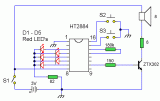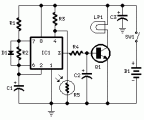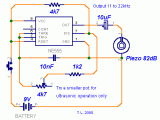FREE
circuits!
Sound and oscillator circuit diagrams
November 30, 2010
This circuit uses the Holtek HT2884 IC to produce 8 different sound effects. [more]
November 25, 2010
There are a number of npn transistors that will oscillate in the audio range when reverse biased. Minimum supply voltage is 7V for low power transistors such as BC109, BC238 and 2N2222A, it becomes 12V... [more]
November 25, 2010
This circuit generates a good 1KHz sinewave using the inverted Wien bridge configuration. [more]
November 10, 2010
Feeling chirpy? Attract new friends with this modified hartley oscillator. You could also use it as a replacement doorbell. [more]
October 27, 2010
Repell those repugnent insects from your Garden this Summer with this insect repellant circuit. Designed by Graham Maynard the circuitry consists of a phase locked loop (CMOS 4047) wired as a 22KHz oscillator. [more]
October 20, 2010
his circuit proved very useful in keeping away from a terrace or a porch some bats and other nocturnal animals. You can use it for similar or different purposes. The lamp illuminates at a 4-5... [more]
October 12, 2010
Here is a simple triangle/squarewave generator using a common 1458 dual op-amp that can be used from very low frequencies to about 10 Khz. The time interval for one half cycle is about R*C and... [more]
October 12, 2010
It's well known that many animals are particularly sensitive to high-frequency sounds that humans can't hear. Many commercial pest repellers based on this principle are available, most of them operating in the range of 30... [more]
October 4, 2010
This circuit is intended for children fun, and can be installed on bicycles, battery powered cars and motorcycles, but also on models and various games and toys. With SW1 positioned as shown in the circuit... [more]
circuit from:http://www.extremecircuits.net/2009/12/two-tone-siren-circuit-schematic-using.html
October 3, 2010
This circuit generates an astonishingly real imitation of the chirping of the cricket. A suitable audio wave form is generated by IC2 and related components, driving the loudspeaker through Q1. To allow a more real-life... [more]
circuit from:http://www.extremecircuits.net/2010/01/cricket-chirping-generator-circuit.html










 This category
This category